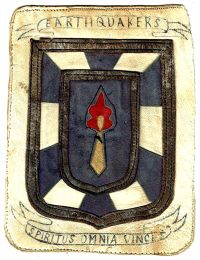12th Bombardment Group: Difference between revisions
| Line 18: | Line 18: | ||
==Aircraft== | ==Aircraft== | ||
North American B-25 Mitchell 1942-1945 <br/> | North American B-25 Mitchell 1942-1945 <br/> | ||
Douglas A-26 Invader 1945-1946 | Douglas A-26 Invader 1945-1946, 1947-1948 | ||
==Commanders (with date of appointment)== | ==Commanders (with date of appointment)== | ||
Revision as of 16:45, 25 April 2022
| 12th Bombardment Group | |||
|---|---|---|---|
| Air Force: 10th Air Force | |||
| Division: | |||
| Wing: | |||
| Active: 1941-1946 | |||
| Theater China-Burma-India | |||
| Motto: Spiritus Omnia Vincet The spirit will conquer all | |||
| Donate | |||
| Even a small donation of a couple of dollars goes a long way in helping | |||
History
The 12th Bombardment Group was a medium bomber group during WWII that flew B-25 Mitchells prior to converting (partially) over to the A-26 Invader. The unit is still active today as the 12th Operations Group and is based at Randolph AFB.
The Group was officially formed on 15 Jan 1941 at McChord Field, Washington, as part of the US buildup of forces. They initially flew coastal anti-submarine patrol routes, which increased in activity between 7 Dec 1941 and the unit's deployment to North Africa in Oct 1942.
In October 1942, the 12th Bomb Group arrived in Egypt and trained with the RAF and South African Air Force. They helped support the British 8th Army and fended off attacks from the German Afrika Corps.
By June 1943 the group had moved to Hergla Airfield, Tunisia and began striking at targets in Italy. In August the group moved to Sicily and continued their assault until Feb 1944.
In March 1944 the unit was transferred to India and began operations in the CBI Theater. The unit was based out of Tezgaon Airfield, Pandaveswar Airfield, Fenny Airfield, and then back to Pandaveswar Airfield. Karachi Airport was the final airbase they were stationed at in India.
At the conclusion of World War II the unit was transferred to Fort Lawton, Washington in Jan 1946 for inactivation.
In May 1947 the Unit was reactivated at Langley Field and flew A-26 Invaders until September 1948 when they were again inactivated.
Aircraft
North American B-25 Mitchell 1942-1945
Douglas A-26 Invader 1945-1946, 1947-1948
Commanders (with date of appointment)
Main Bases
McChord Field, Washington, 15 January 1941
Esler Field, Louisiana, c. 21 February-3 July 1942
RAF Deversoir, Egypt, c. 31 July 1942 (group headquarters and support elements after October 1942)
Egypt and Libya, c October 1942-c April 1943
Medenine Airfield, Tunisia, 3 April 1943
Sfax Airfield, Tunisia, c. 15 April 1943
Hergla Airfield, Tunisia, 2 June 1943
Ponte Olivo Airfield, Sicily, Italy, c. 2 August 1943
Gerbini Airfield, Sicily, Italy, c. 22 August 1943
Foggia Airfield, Italy, c. 2 November 1943
Gaudo Airfield, Italy, 19 January-6 February 1944
Tezgaon Airfield, India, c. 21 March 1944
Pandaveswar Airfield, India, 13 June 1944
Fenny Airfield, India, 16 July 1944
Pandaveswar Airfield, India, 8 June 1945
Karachi Airport, India, 15 November-24 December 1945
Fort Lawton, Washington, 21–22 January 1946
Langley Field (later Langley Air Force Base), Virginia, 19 May 1947 – 10 September 1948
Turner Air Force Base, Georgia, 1 November 1950
Bergstrom Air Force Base, Texas, 5 December 1950[24] – 16 June 1952
Randolph Air Force Base (later Joint Base San Antonio-Randolph Air Force Base), Texas, 15 December 1991 – present
Component Units
81st Bombardment Squadron: 1941-1946
82nd Bombardment Squadron: 1941-1946
83rd Bombardment Squadron: 1941-1946
434th Bombardment Squadron: 1941-1946
Assigned To
1944-45: Tenth Air Force
Photos
Sources
Deaile, Melvin G. (2007). The SAC Mentality: The Origins of Organizational Culture in Strategic Air Command 1946–1962. Chapel Hill, NC: University of North Carolina. Knaack, Marcelle Size (1978). Encyclopedia of US Air Force Aircraft and Missile Systems (PDF). Vol. 2, Post-World War II Bombers 1945–1973. Washington, DC: Office of Air Force History. ISBN 0-912799-59-5. Maurer, Maurer, ed. (1983) [1961]. Air Force Combat Units of World War II (PDF) (reprint ed.). Washington, DC: Office of Air Force History. ISBN 0-912799-02-1. LCCN 61060979. Retrieved 17 December 2016. Maurer, Maurer, ed. (1982) [1969]. Combat Squadrons of the Air Force, World War II (PDF) (reprint ed.). Washington, DC: Office of Air Force History. ISBN 0-405-12194-6. LCCN 70605402. OCLC 72556. Retrieved 17 December 2016. Mueller, Robert (1989). Air Force Bases, Vol. I, Active Air Force Bases Within the United States of America on 17 September 1982 (PDF). Washington, DC: Office of Air Force History. ISBN 0-912799-53-6. Ravenstein, Charles A. (1984). Air Force Combat Wings, Lineage & Honors Histories 1947–1977. Washington, DC: Office of Air Force History. ISBN 0-912799-12-9. Retrieved 17 December 2016. Stahura, Barbara (1998). Earthquakers: 12th Bombardment Group (M). Turner Publishing Company. ISBN 978-1-56311-414-4. Tucker, Lt Col Charles H.; Bledsoe, Larry W. (Winter 2017). "U.S. Army Air Force 12th Bombardment Group in WWII "The EARTHQUAKERS"". AAHS Journal. American Aviation Historical Society. 62 (4): 279–289.

